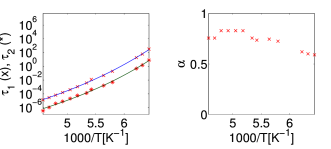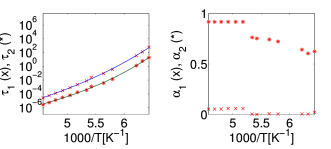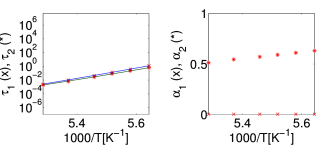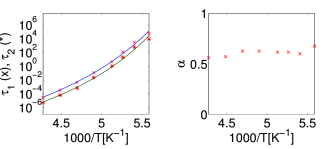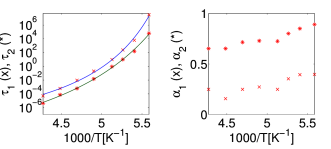5 Temperature dependence of the parameters
[page 1287, §1]
[1287.1.1] Because the data have been fitted at different temperatures we are able
to observe the temperature dependence of the fitting parameters.
[1287.1.2] For τ1 and τ2 we perform Vogel-Tammann-Fulcher fits
provided by equation (13).
[1287.1.3] From the fits we obtain the Vogel-Fulcher temperatures TVF1 and
TVF2 as well as the fragility parameters D1 and
D2 for the relaxation times τ1 and τ2
for model A and model B (see Table 2).
| material |
model |
TVF1 |
TVF2 |
D1 |
D2 |
τ01 |
τ02 |
| 5-methyl-2-hexanol |
A |
89.2K |
92.1K |
25.5 |
22.1 |
3.53×10-13s |
7×10-14s |
| 5-methyl-2-hexanol |
B |
88.3K |
101.6K |
26.3 |
15.3 |
5.21×10-13s |
5.77×10-12s |
| methyl-m-toluate |
A |
71.2K |
71.2K |
93.2 |
93.2 |
4.35×10-28s |
1.54×10-28s |
| methyl-m-toluate |
B |
67.2K |
85.6K |
102.2 |
53.6 |
9.0×10-28s |
1.13×10-22s |
| glycerol |
A |
127.8K |
131.5K |
17.1 |
14.9 |
3.7×10-14s |
3.23×10-14s |
| glycerol |
B |
152.7K |
137.8K |
6.68 |
11.9 |
2.9×10-10s |
2.15×10-13s |
Table 2:
List of the fit parameters TVF, D and τ0
for various materials.
[1287.2.1] For all fits we see a temperature dependence of the
relaxation times τ1 and
τ2 (Fig. 4 - Fig. 6)
that follows the Vogel-Tammann-Fulcher fitting function remarkably well.
[1287.2.2] The relaxation times also show a clear downward trend as the
temperature increases, which confirms that τ, τ1 and
τ2 are physically
meaningful and can be interpreted as relaxation times
even tough they appear with a non-integer power in equations
(11) and (12).
[1287.3.1] The parameters α, α1 and α2 also
show a temperature dependence.
[1287.3.2] In the case of 5-methyl-2-hexanol (Fig. 4)
there is an increase of α with temperature until a plateau
near α=1 is reached.
[1287.3.3] This effect comes from the decreasing slope of the excess wing with
increasing temperature.
[1287.3.4] In the fitting function of model A this behavior can be achieved by
increasing α.
[1287.3.5] For the same material there is an apparent increase of α2 between
154K (6.49K-1) and 287K (3.48K-1)
which has the same origin as the increase in α in model A.
[1287.3.6] By increasing α2 the excess wing becomes less steep.
[1287.3.7] The plateau at 190K (5.26K-1) and above comes
from the fact that the fits at those
temperatures are done mainly for the α-peak,
because the excess wing is not visible.
[1287.4.1] For methyl-m-toluate and glycerol there is also a clear temperature dependence
of α, α1 and α2
(Fig. 5 and Fig. 6).
[1287.4.2] The trend is however reversed in comparison to 5-methyl-2-hexanol.
[1287.4.3] This comes from the increasing slope of the excess wing with
increasing temperature.
[1287.4.4] This behavior can be achieved in the fit functions by decreasing α,
respectively α2.
